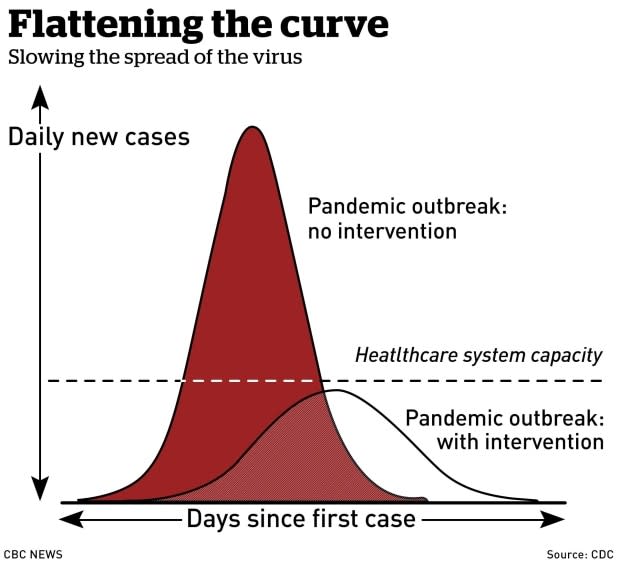Canadians being urged to help 'flatten the curve' of COVID-19

The dispatches from the front lines of the COVID-19 outbreak in northern Italy are chilling.
"Nurses with tears in their eyes because we can't save everyone … Every ventilator becomes like gold."
That was the message last week from Dr. Daniele Macchini, an Italian physician whose lengthy Facebook post was published in a local newspaper, translated into English and circulated on social media.
"And there are no more surgeons, urologists, orthopedists; we are only doctors who suddenly become part of a single team to face this tsunami that has overwhelmed us," he wrote.
Three professors from the University of Milan also sent a letter warning doctors in the rest of Europe to "get ready," because 10 per cent of patients who test positive for COVID-19 end up needing intensive care.
"This situation is like a bomb that explodes, and you're simply overwhelmed by an incredible number of patients," another Italian physician, Dr. Giacomo Grasselli, told the CBC News Network this week.
WATCH | Italian doctor says coronavirus is like a bomb that exploded:
Grasselli is co-ordinating the intensive care response in Milan, the largest city in the country's hard-hit northern region. All of Italy's 60 million people are now under a sweeping lockdown, subject to travel and social restrictions aimed at curbing the spread of Europe's worst outbreak of coronavirus.
"We're living this now," said Grasselli. "My mission is not only to take care of Italian patients, but also to tell other people in the world how to get ready for this."
There's still time to 'flatten the curve'
Canada still has time to avoid such a situation, experts say.
As the global number of coronavirus cases nears 120,000 people in 115 countries, chances of stopping its spread are now considered unlikely. So public health officials have turned their attention to slowing it down.
And the key is to "flatten the curve" — a reference to an epidemiological graph of a disease outbreak.
A large spike on that graph, representing a sudden increase in people with infections, can be catastrophic even for health-care systems in highly developed countries like Canada.

"If you can slow it down enough and flatten the curve, so the same number of people get infected, but over a much longer period of time, then ... what you're allowing is that the capacity will not be exceeded," said Dr. Anand Kumar, a critical care physician at Winnipeg's Health Science Centre.
"And that protects the community, so that an ICU bed will be available when it's needed."
Most healthy people will experience a mild COVID-19 infection because their immune system will protect them. But so far, the experience in Italy and China suggests that as many as 10 per cent of people infected can require critical care.
That creates an urgent need for beds in intensive care units, along with ventilation, dialysis and other life support technology. It also requires qualified health-care specialists to manage patients — excess capacity that Canadian hospitals just don't have.
"We're at capacity most of the time." - Dr. Robert Fowler, critical care physician and researcher
Most of the country's hospitals are already operating at 100 per cent capacity, a largely normal situation in Canada's health-care system.
"We've got a system that is designed to meet what our usual demands are," said Dr. Robert Fowler, a critical care physician at Toronto's Sunnybrook Hospital. "We're at capacity most of the time."
Add to that the extra load from this year's bad flu season, and suddenly, even in Canada, there's a risk that care might not be available when patients need it.
"Ideally, you prevent people from being infected — but you certainly don't want to have everybody infected at once," said Fowler. "We don't want to overwhelm the system."
But the Italians warn that could happen.
"If you do not stop the spread of the disease, your health system — no matter how good, how efficient, how modern it is — sooner or later will collapse," said Grasselli. "Because the number of patients is too high for the resources we have everywhere in the world."
That's why in Canada (and elsewhere) large events are being cancelled, some people are being told to work from home, and some students will be taking courses online for a few weeks. It's a temporary public health strategy aimed at slowing the potential spread and buying time.
"That's what people are trying to do to try to prevent the spread right now so we don't get overwhelmed," said Fowler. "And it's going to very much depend on how effective we are at preventing transmission in the community."

Another complicating factor is the fact that there is no vaccine and there are no drugs to treat COVID-19.
"In this particular circumstance, we're not going to have a vaccine for at least a year, if not a year-and-a-half," said Kumar. "And there's no known antiviral drug for coronavirus, so essentially all we can offer is supportive care.
"If you get mildly ill, there's not something we can give you to stop you from getting severely ill. So what's going to happen is going to happen. And we're just going to have to try to support patients as best we can."
The importance of beds, ventilators
Fowler led a team of researchers that conducted a survey of Canada's critical-care capacity after the 2009 H1N1 epidemic. At the time, there were about 3,200 ICU beds and almost 5,000 mechanical ventilators spread out in 286 hospitals across Canada.
Ventilators are mechanical breathing machines that will be critical for COVID-19 patients whose lungs are so badly damaged they have trouble getting enough oxygen.
The survey concluded that intensive care resources vary widely across Canada and "during times of increased demand, may result in geographic differences in the ability to care for critically ill patients."
Ontario, for example, had an extra 209 ventilators stockpiled and spread out across the province as of last August, according to one provincial document.

"The physical space within a hospital to care for people is, I think, probably even more challenging beyond the physical number of ventilators," said Fowler.
Kumar is particularly concerned about the number of qualified staff to handle a possible surge in patients.
"The bottleneck is in manpower, even more than physical space and even ventilators," he said. "I think everybody is contingency planning for the possibilities."
Some of the challenges now relate to approaching the management of COVID-19 on a national scale — and being ready to help regions that are hit harder, experts say. That may involve moving equipment and health-care workers to where they are most urgently needed.
"There's patchiness in where these outbreaks hit," said Fowler. That means doctors and nurses can be completely overwhelmed in one place, but it can be business as usual in the rest of the country.
In Italy, health-care workers are already talking about the grim reality of "triaging" under strained circumstances, which means they're being forced to choose between life and what might have been a preventable death for some people, based on the availability of ventilators and ICU beds.
Canada has studied the concept of such triaging, but Fowler said so far no system has been established.
"In Canada, we don't really have a working example of what that would look like and we haven't had to do that," he said.
"We shouldn't be having that conversation ahead of the conversation about when a place gets busy, how can we bring support."


